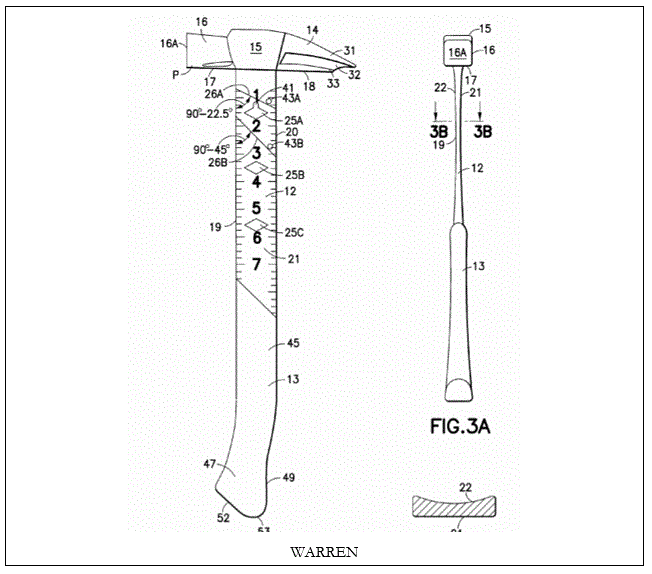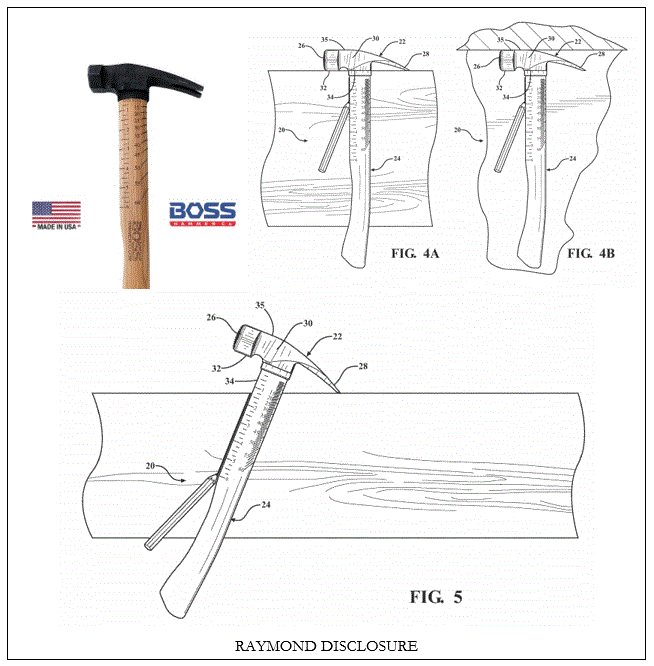At the University of Missouri, my patent law class is practice based – with students drafting claims, rejecting claims, responding to office actions, and participating in a patent law moot court competition. The class is pretty much fully packed. Still, I also give them a short final exam to ensure sure that they have learned the basics. This year’s exam is based upon an actual pending patent application for the Boss Hammer. Note – I played with the actual facts and claims a bit to make it all more straightforward.
= = = =
Introduction: Daniel Raymond is the inventor of the “Boss Hammer” shown below. The hammer works as a conventional claw-hammer that might be used by a carpenter or house framer, but also has several secondary functions. You can see the ruler being used in the drawings below. The head of the hammer is slightly wider than the handle that allows it to rest atop a board (FIG 4A) and is arranged so that the handle extends out at a right-angle when the head is resting on the board. The head of the hammer is standard width (here 1-inch) so that it can form part of the measurement (FIG 4B). The hammer also includes a set of angle marks calibrated with the claw end (FIG 5). This replaces a carpenter square so that you wouldn’t need to carry so many tools.
Raymond’s patent application claims a March 2019 effective filing date and includes the description and drawings above. The application is currently pending before the USPTO with the following claims:
1. A hammer, comprising: a head; and a handle extending from said head;
wherein said head includes (a) a nail-striking section having a base surface and (b) a nail-pulling section having a pair of claws, each claw having an end;
wherein the claw ends share a common plane with the base surface of the nail-striking section; and wherein no other portions of the claws share a common plane with the base surface of the nail-striking section;
wherein at least a portion of said handle extends linearly and perpendicularly to said common plane for allowing a user to draw a straight line which is perpendicular to the common plane.
2. The hammer as set forth in claim 1 wherein said handle further includes angle indicia which indicates angles relative to said ends of said claws for allowing a user to draw a straight line which is non-perpendicular to the common plane.
[Note: I did not provide the students with this, but you can read Raymond’s published patent application here: Raymond Published App (Patent Center link). Likewise with the prior art: Warren Patent Prior Art].
Prior to filing the patent application, Raymond formed a new company (Boss Hammer Co.) and assigned his rights to the patent application to the new company.
One key prior art reference has been identified by the USPTO Examiner: U.S. Patent No. 7,621,503 (“Warren”). That patent has now expired, but the Patent Examiner identified it as prior art because Warren’s patent application was filed in 2005 and the patent issued in 2009.

= = = = =
Question 1. Is Raymond’s claim 2 directed toward eligible subject matter?
Question 2. Provide a concise argument why the USPTO should reject claim 1 as indefinite.
Question 3. Raymond is concerned that his pre-filing assignment of rights (discussed above) might block him from receiving a patent. In particular, the transfer document is labelled a “sale of patent rights” and recite $1 as consideration. Will the assignment of rights cause his company problems under Section 102?
Question 4. Should Warren bar Raymond from obtaining a patent?
Question 5. Higher-end hammer-heads are often made of titanium and it is well known in the industry how to form hammer-heads out of the metal. In his patent application, Raymond only disclosed Steel as a material for the hammer head. Raymond has suggested to his attorney that he would like to add a claim limitation directed to a titanium head. Raymond correctly notes that, after reading his application, someone skilled in the art would be able to make-and-use a titanium version of his invention. Can he amend the claims to add the titanium-head element? (Consider only written description and enablement requirements).
Question 6. It is now 2022: Raymond obtained a patent covering claim 1 in 2021. Later that year, IKEA began selling a similar hammer for its customers to use when assembling furniture.[1] The key difference between what Raymond sells and IKEA’s is that IKEA’s hammer-head is rubber-coated metal. In addition, IKEA sells the hammer unassembled with instructions for assembly. (It comes in two separate pieces –head and handle). Will Raymond be able to show that IKEA infringes?
[1] IKEA sells its furniture unassembled, and it is a notoriously laborious process to assemble some items.
= = = = =
The hammer here looks pretty cool and would be a great holiday gift for your patent attorney friends. Wrap it in the drawings from the patent application.


I’ll give it a shot:
1. No. The first step is to determine what the claim is directed to. The claim is directed to two fundamental mathematical measurement tools – a ruler and a protractor. The second step is to determine if the claim contains anything additional that renders the claim significantly more than the ineligible subject matter to render it protectable. The given of the problem states that the claw hammer is conventional, which means it is not significantly more. While novel measurement devices can impart eligibility (Diamond v Diehr, I know some people may misinterpret this holding) cases generally turn on whether they gather new data or do so in a new way (Electric Power Group). See MPEP 2106.05(a)(II).
2. It is unclear if “for allowing a user to draw a straight line which is perpendicular to the common plane” is intended use or a structural limitation. Regardless, it is a claim to a function without structural limitation and makes it unclear what acts are encompassed by the scope. I also would complain that “nail-striking section” and “nail-pulling section” are either nominal terms for the sections or may impart functional limitations on the sections, but that may be settled by the specification. See MPEP 2173.05(g).
3. Sale of patent rights has not historically been a sale for the on sale bar (MPEP 2133.03(b)(I)(d)). And given that no date for the sale was given, even if there was some sort of argument that this is an “otherwise available to the public” situation, it’s unclear why it wouldn’t be exceptioned out under 102(b)(1)(A). See MPEP 2153.01.
4. Yes. Raymond is obvious over the Warren reference. While this is a case of functional descriptive material that gives weight to the writing limitations, the “the angle-lines in Warren are relative to the nail-striking portion while Raymond proposes that these be drawn relative to the claw” distinction is either simple substitution or obvious to try. MPEP 2143. The “in Warren, the entire base of the head is flat while Raymond’s head includes the curved claws” distinction is an obvious change in shape because the plane could be formed with a point on either end rather than extending the line the entire way. Changes in shape without evidence of criticality are obvious, see MPEP 2144.04(IV)(B). Arguments that the head is more agile are insufficient because arguments of counsel are insufficient when evidence is necessary. 716.01(c).
5. No. The specification does not disclose titanium and written description is an inventor-specific test, so the fact that the art was enabled to do it is irrelevant. Written description violation. MPEP 2163(II)(3)(b). Bonus points (as it’s clear that most practicing attorneys don’t know this) for stating that it would also be an enablement rejection because the supplementary rule does not apply. The fact that one of skill in the art would be enabled to make a titanium head is irrelevant because 112 requires the specification to teach how to make and use the invention and the supplemental rule does not activate when there is nothing in the specification to supplement. (Genentech, and unfortunately only MPEP2161.01(III), when it should also be in 2164)
6. Yes. There’s no limitation on the head material (and it would be equivalent anyway) so the item infringes but-for being integral and the item encourages the integration, so this is inducement or contribution or whatever.
Random,
Let me know when you get your grade (and understand why you received the grade that you did).
So…
What was your grade Random, and do you think it fair and accurate?
Oh wait, you will never see that.
Get your grades yet?
How long are you going to wait?
As an example of an ongoing series that you have provided (with less and less responses over time), Prof Crouch, you may generate some conversation were you to follow up with your grading metric.
I understand that there may be a variety of reasons for not doing so, but these “are you smarter than” types of threads that remain ‘open’ are generally not worth engaging because of their remaining ‘open.’
I don’t understand your point here anon.
This type of post simply gains less and less traction, even as you continue to use it year over year.
Maybe if you ALSO provided your rubric, THEN a discussion might ensue.
As it is, meh, not so much interest.
Comments are closed.